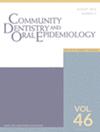Recent dental visits and family caregiving among individuals with dental symptoms: A nationwide cross-sectional study in Japan
Abstract
Objectives
With the increasing number of family caregivers due to the ageing population, physical and mental health problems among caregivers are of concern. However, few studies have evaluated their oral health. This study aimed to evaluate the association between being a family caregiver and recent dental visits for dental symptoms in Japan, with consideration of gender.
Methods
A cross-sectional study was conducted using the 2016 Comprehensive Survey of Living Conditions (CSLC) in Japan. Participants with dental symptoms were included in this study. The primary outcome was recent dental visits. The exposure variable of interest was being a primary caregiver for a family member requiring long-term care. A logistic regression analysis was conducted adjusting for contributing factors such as age, gender, marital status, working hours per week, education, household expenditure per month, self-rated health and the interaction between gender and caregiving. A stratified analysis by gender was also performed.
Results
Of the 5100 eligible participants, 233 (4.6%) were family caregivers. Of all participants, 2746 (53.8%) reported dental visits. The adjusted odds ratio (aOR) of family caregivers having recent dental visits was 0.83 (95% confidence interval [CI], 0.64–1.09). In a gender stratified analysis, family caregivers were less likely to visit dental clinics than were non-family caregivers in the male subsample (aOR: 0.56, 95% CI: 0.34–0.92) but not in the female subsample (aOR: 0.99, 95% CI: 0.72–1.38).
Conclusions
The findings indicate that family caregivers, especially male caregivers, had fewer dental visits than non-family caregivers. These findings suggest the need to improve the accessibility of dental clinics to family caregivers with dental symptoms.

 求助内容:
求助内容: 应助结果提醒方式:
应助结果提醒方式:


